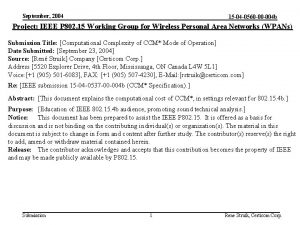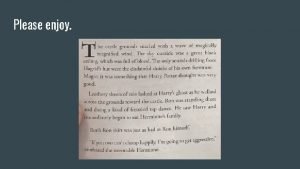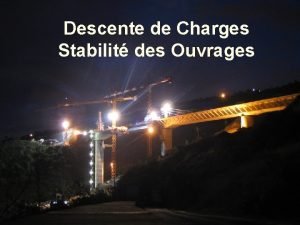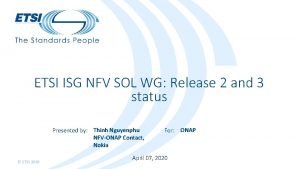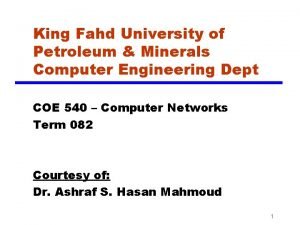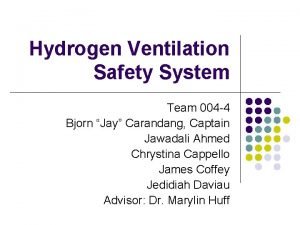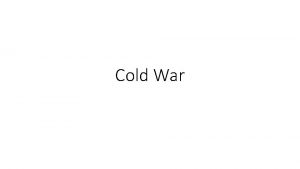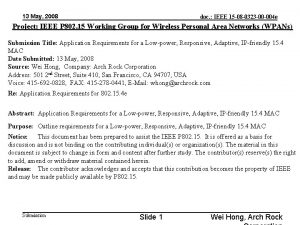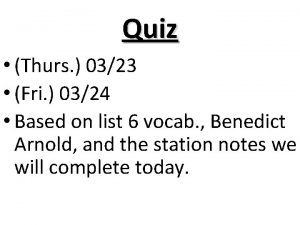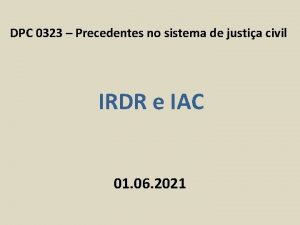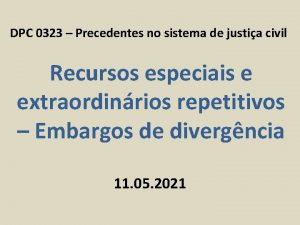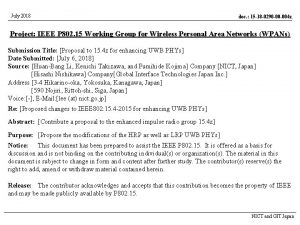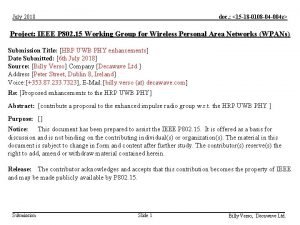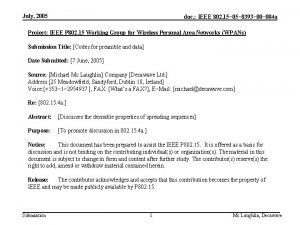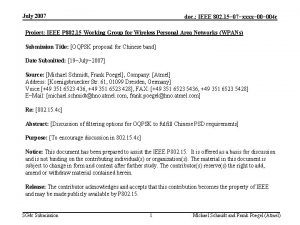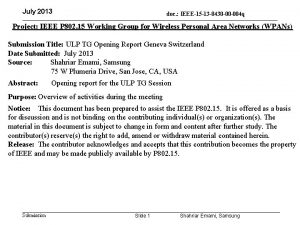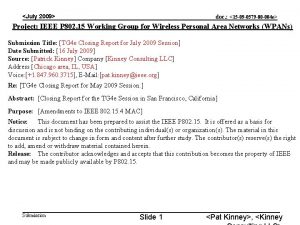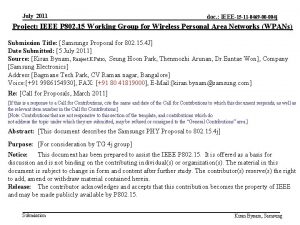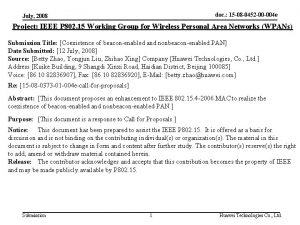doc 15 18 0323 00 004 z July
















- Slides: 16

doc. : <15 -18 -0323 -00 -004 z> July 2018 Project: IEEE P 802. 15 Working Group for Wireless Personal Area Networks (WPANs) Submission Title: [HRP data mode options] Date Submitted: [6 th March 2018] Source: [Prof Tony Fagan, Michael Mc. Laughlin] Company [Decawave Ltd. ] Address [Peter Street, Dublin 8, Ireland] Voice: [+353. 87. 233. 7323], E-Mail: [billy. verso (at) decawave. com] Re: [data modes for the HRP UWB PHY] Abstract: [contribute to the enhanced impulse radio group w. r. t. the HRP UWB PHY ] Purpose: [] Notice: This document has been prepared to assist the IEEE P 802. 15. It is offered as a basis for discussion and is not binding on the contributing individual(s) or organization(s). The material in this document is subject to change in form and content after further study. The contributor(s) reserve(s) the right to add, amend or withdraw material contained herein. Release: The contributor acknowledges and accepts that this contribution becomes the property of IEEE and may be made publicly available by P 802. 15. Submission Slide 1 Prof Tony Fagan, Decawave Ltd.

doc. : <15 -18 -0323 -00 -004 z> July 2018 802. 15. 4 a Data Modulation • In 802. 15. 4 a the data modulation is BPM-BPSK where one burst of pulses is sent every symbol time and a data symbol looks like this: Submission Slide 2 Prof Tony Fagan, Decawave Ltd.

doc. : <15 -18 -0323 -00 -004 z> July 2018 802. 15. 4 a 6. 8 Mbps at 64 MHz (6. 8 A) • • For 6. 8 Mbps data at the nominal PRF of 64 MHz, the symbol rate is ~8 MHz and the symbol time is approximately 128 ns consisting of 64 2 ns chips. Each burst consists of 8 pulses with 2 ns spacing giving a 16 ns long burst of pulses. The UWB restrictions in the US, Europe and other places limit the mean power in 1 ms to be -41. 3 d. Bm/MHz and they limit the peak power to be 0 d. Bm in any 50 MHz bandwidth. This 50 MHz limit effectively limits the amount of power in any 20 ns period of signal to be 0 d. Bm or 1 m. W. All 8 pulses fit inside this 20 ns, – so each pulse is limited to 0. 125 m. W. Submission Slide 3 Prof Tony Fagan, Decawave Ltd.

doc. : <15 -18 -0323 -00 -004 z> July 2018 802. 15. 4 a 6. 8 Mbps at 64 MHz (6. 8 A)- Spectrum • Because some 20 ns segments of signal have 8 pulses in them the spectral peak to average ratio (SPAR) is very high (32 d. B) Peak Spectrum generated with a rectangular FFT window. Hamming window generates a similar spectrum. Submission Slide 4 Prof Tony Fagan, Decawave Ltd.

doc. : <15 -18 -0323 -00 -004 z> July 2018 6. 8 Mbps, 64 MHz 8 ns grid proposal (6. 8 B) • • If the pulse spacing was increased from 2 ns to 8 ns this would provide a number of benefits Any 20 ns segment, i. e. 50 MHz bandwidth, encompasses only 3 pulses, so each pulse can be at 0. 33 m. W – Each pulse can be increased in power by at least 4. 3 d. B compared to current 6. 8 Mbps scheme and have the same 0 d. Bm 50 MHz peak power giving a 64% or more range advantage • Typically, length of pulses is at least 5 ns so 4 pulse generators need to be used to implement current 802. 15. 4 a scheme. This scheme only requires 1 pulse generator. Submission Slide 5 Prof Tony Fagan, Decawave Ltd.

doc. : <15 -18 -0323 -00 -004 z> July 2018 6. 8 Mbps, 8 ns grid proposal (6. 8 B) - Spectrum • • Because 20 ns segments of signal can only have 3 pulses in them the spectral peak to average ratio (SPAR) is better (25. 5 d. B) Requires transmitter to be able to generate 1. 38 Volts peak at the antenna which is very difficult with standard CMOS without an external amplifier. Peak Spectrum generated with a rectangular FFT window. A Hamming window results in a lower peak spectrum. Submission Slide 6 Prof Tony Fagan, Decawave Ltd.

doc. : <15 -18 -0323 -00 -004 z> July 2018 6. 8 Mbps, 64 MHz (6. 8 B) proposal cont. • • Retains 4 a BPM-BPSK modulation – Allows reception by non-coherent receiver This scheme has no hopping – No need for spectrum whitening with the scrambler – The extra spreading of the pulses helps against multipath • • Submission This scheme has no guard time, but wider spread of pulses improves multipath immunity. Simulations over IEEE 802. 15. 4 a channel model CM 1 multipath channel show no receiver sensitivity loss sue to multipath. Slide 7 Prof Tony Fagan, Decawave Ltd.

doc. : <15 -18 -0323 -00 -004 z> July 2018 Other Possible 6. 8 Mbps Schemes • Scheme (6. 8 C) – Burst of 8 pulses with 8 ns separation. 8 bits generated by rate 1/8 convolutional encoder and used to assign polarity of 8 pulses • • • Submission 8 bits from rate 1/8 convolutional code and then scrambled Has same peak spectrum as BPM-BPSK scheme Uses different modulation than 802. 15. 4 a Not compatible with non-coherent receiver Has a 70 ns guard interval to protect against multipath Slide 8 Prof Tony Fagan, Decawave Ltd.

doc. : <15 -18 -0323 -00 -004 z> July 2018 Other Possible 6. 8 Mbps Schemes • Scheme (6. 8 D) – Burst of 8 pulses with 12 ns separation. 8 bits generated by rate convolutional encoder and used to assign polarity of 8 pulses • • • Submission 8 bits from rate 1/8 convolutional code and then scrambled Has better peak spectrum than 6. 8 B but no better than the preamble Uses different modulation than 802. 15. 4 a Not compatible with non-coherent receiver Has a 42 ns guard interval to protect against multipath Slide 9 Prof Tony Fagan, Decawave Ltd.

doc. : <15 -18 -0323 -00 -004 z> July 2018 Performance over multipath channel CM 1 • Matlab simulations over IEEE 802. 15. 4 a channel model CM 1 multipath channel shows that scheme 6. 8 B has identical performance to 6. 8 A. Scheme 6. 8 C has very slightly better performance consistent with the higher hamming distance of the rate 1/8 code (21 vs 20 for 8 pulses) Submission Slide 10 Prof Tony Fagan, Decawave Ltd.

doc. : <15 -18 -0323 -00 -004 z> July 2018 6. 8 Mbps summary • Decawave proposes that 4 z adopts scheme 6. 8 B as an option – Potential of up to 6 d. B better performance – Translates to twice range of current 6. 8 Mbps mode assuming the transmitter is peak voltage limited to ~0. 7 Volts at the antenna – Extra performance does require transmitter to be able to generate well in excess of 1. 38 Volts peak. – The other possible options which we discussed are not compatible with BPM-BPSK modulation Submission Slide 11 Prof Tony Fagan, Decawave Ltd.

doc. : <15 -18 -0323 -00 -004 z> July 2018 802. 15. 4 a 27 Mbps at 64 MHz (27 A) • • • For 27 Mbps data at the nominal PRF of 64 MHz, the symbol rate is ~32 MHz and the symbol time is approximately 32 ns consisting of 16 2 ns chips. Each burst consists of 2 pulses with a 2 ns spacing between them This 50 MHz limit effectively limits the amount of power in any 20 ns period of signal to be 0 d. Bm or 1 m. W. Possible for 4 pulses appear inside this 20 ns Submission Slide 12 Prof Tony Fagan, Decawave Ltd.

doc. : <15 -18 -0323 -00 -004 z> July 2018 802. 15. 4 a 27 Mbps at 64 MHz (27 A)- Spectrum • Because some 20 ns segments of signal have 4 pulses in them the spectral peak to average ratio (SPAR) is quite high (24 d. B) Peak Spectrum generated with a rectangular FFT window. Submission Slide 13 Prof Tony Fagan, Decawave Ltd.

doc. : <15 -18 -0323 -00 -004 z> July 2018 27 Mbps, 8 pulse proposal (27 B) • • • If the number of pulses is increased from 2 to 8 this provides a number of benefits in a standard CMOS IC Assuming the pulses are the same amplitude as in the preamble etc. each bit has 6 d. Bs more energy The standard 27 Mbps mode (27 A) could have pulses with twice the amplitude of the pulses used for 6. 8 Mbps, but this is not generally possible for two reasons: (1) Receiver gain, AGC, thresholds have been trained with the preamble pulses (2) Standard CMOS in a 40 nm process can only generate about 0. 75 V peak over PVT corners at the antenna because: – There are losses of 6 d. B or more after the signal is generated before it reaches the antenna • 8 GHz is a high frequency for standard CMOS • Considerable loss in the balun • Losses in the Tx/Rx switches • Losses in the tracks • Losses in the antenna feed and the antenna itself • Losses higher at higher temperatures (must work to 105⁰C) Submission Slide 14 Prof Tony Fagan, Decawave Ltd.

doc. : <15 -18 -0323 -00 -004 z> July 2018 27 Mbps, 8 pulse proposal (27 B) cont. • Using existing convolutional encoder (16. 3. 3. 2), use output g 0 to select 1 of 2 pulse sequences, and g 1 to invert or not. • • • This standard rate 1/8 convolution code comes from Proakis Then scramble v(n) using the existing scrambler (16. 3. 2), giving 8 chips per burst and 8 chips guard interval Same spectrum as standard 6. 8 Mbps mode (6. 8 A) Simulations show that this mode has the same performance at 6. 8 Mbps over an AWGN channel, as expected. Simulations over the IEEE 802. 15. 4 a CM 1 channel model show just 1 d. B is lost due to multipath. Submission Slide 15 Prof Tony Fagan, Decawave Ltd.

doc. : <15 -18 -0323 -00 -004 z> July 2018 27 Mbps summary • Decawave proposes that 4 z adopts scheme 27 B as an option for 27 Mbps – 6 d. B better performance giving of current 27 Mbps mode – Translates to the same range of current 6. 8 Mbps mode assuming the transmitter is peak voltage limited to ~0. 7 Volts at the antenna – Power consumption for transmit and receive data portion of the frame is ¼ that of the current 6. 8 Mbps mode but has an equal range Submission Slide 16 Prof Tony Fagan, Decawave Ltd.

